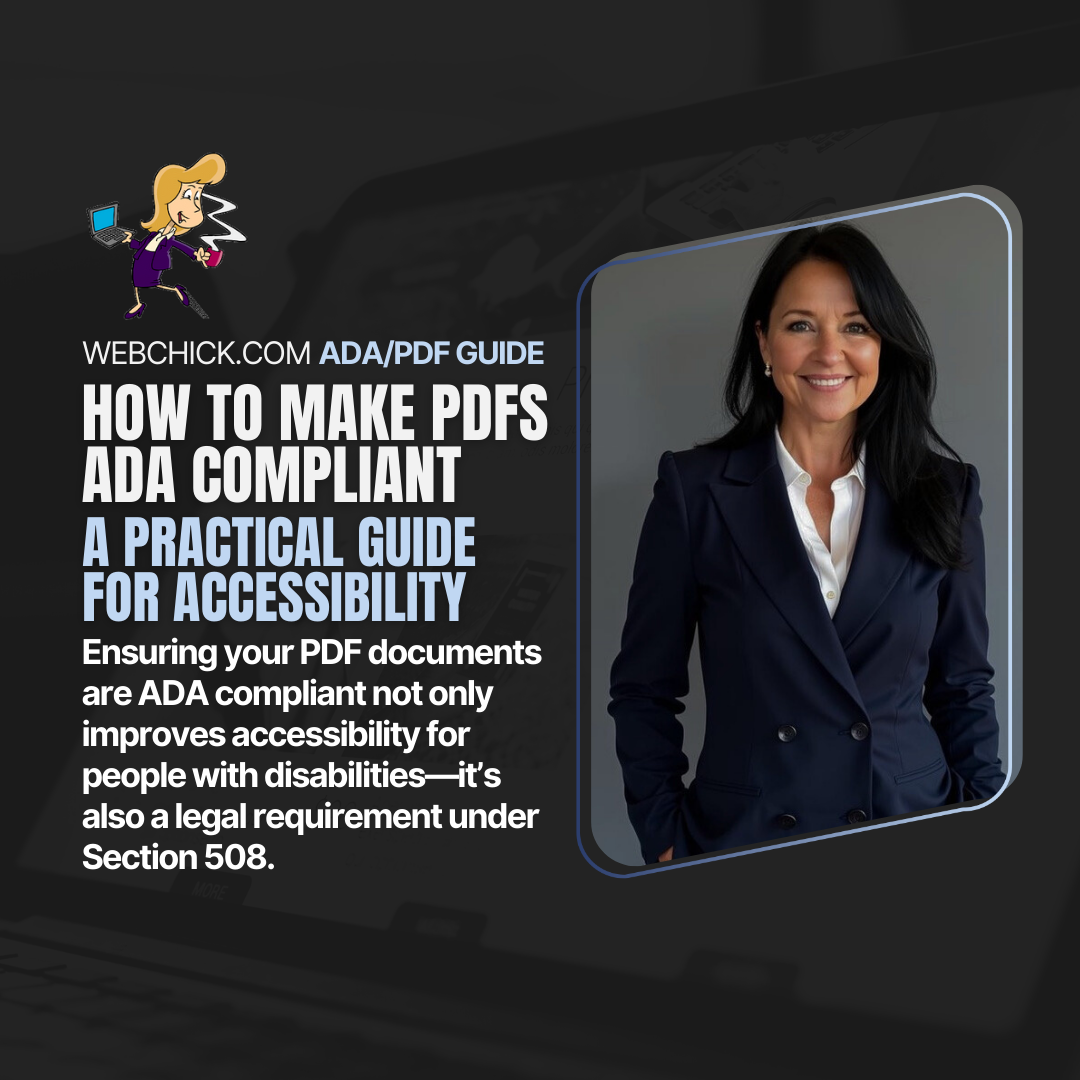
The Daily Brew:
How to Make PDFs ADA Compliant:
A Practical Guide for Accessibility
Brewed fresh by WebChick – your go-to for websites that work harder.
Ensuring your PDF documents are ADA compliant not only improves accessibility for people with disabilities—it’s also a legal requirement under Section 508. This guide walks you through the process from start to finish with visuals and practical tips.
Making Microsoft Word Documents ADA Compliant
Creating ADA-compliant documents in Microsoft Word is essential for ensuring accessibility for all users, including individuals who rely on screen readers. Whether you're designing forms, reports, or educational content, following accessibility guidelines helps make your content usable, readable, and inclusive.
Below is a quick reference guide to making your Word documents accessible and compliant with WCAG and Section 508 standards:
Key Steps to Create an Accessible Word Document:
- Select All Text to standardize formatting before applying accessibility features.
- Align Left for easy readability—avoid center or justify.
- Use Sufficient Color Contrast and set font color to “Automatic” (usually black).
- Choose Accessible Fonts like Calibri, Arial, or Times New Roman, size 12 or larger.
- Set a Default Font and Size for consistency across future documents.
- Create a Document Title using the “Title” style for screen reader recognition.
- Apply Proper Headings using Heading 1, Heading 2, etc., in logical order.
- Avoid Skipping Heading Levels (e.g., never jump from H1 to H4).
- Use Bullet Points to break up text and enhance visual clarity.
- Add Alt Text to images to describe content for screen reader users.
- Keep Links Descriptive (e.g., "Download Checklist" instead of “www.link.com”).
- Use Headers and Footers sparingly, ensuring they don’t distract from core content.
- Insert a Table of Contents that reflects your heading structure.
- Use Page Breaks instead of multiple line returns for cleaner formatting.
- Run the Accessibility Checker (Review > Check Accessibility).
- Review Readability Statistics (aim for Flesch Reading Ease 60–70 and Grade Level 7–8).
- Export as a Tagged PDF using the Acrobat tab or “Save As PDF” with options enabled.
Web Chick Note - COMMON ISSUES:
• Missing Language
• Missing Title
• Author (no Comma on name)
• List issues
• Missing H1 (Heading - Title) missing
Taking the time to format your Word document properly not only ensures ADA compliance but also improves the usability of your content for everyone. Whether you're creating a training manual, public-facing form, or business report, these steps are essential for inclusive communication.
▶ Creating Accessible Word Documents [VIDEO]
▶ Introduction to Web Accessibility and W3C Standards [VIDEO]
▶ Creating Accessible Word Documents
Make Scanned PDFs Searchable with OCR
(Searchable Text, Tagging, and Accessibility Basics in Adobe Acrobat Pro)
If your PDF was created from a scanned document or image file (like JPG, PNG, or GIF), it likely isn’t readable by screen readers — which means it's not ADA compliant. To fix this, you'll need to convert it into searchable text using OCR (Optical Character Recognition) and follow up with proper accessibility checks.
Step 1: Convert Scanned Files to Searchable Text (OCR)
For scanned PDFs:
- Open Adobe Acrobat Pro.
- Click File > Open and select your scanned PDF.
For image files (JPG, PNG, GIF, etc.):
- Open Acrobat Pro and go to Tools > Create PDF.
- Choose Single File, then select your image.
- Click the Create button to convert it to a PDF.
Next: Go to Tools > Enhance Scans. Click Recognize Text > In This File. Start the OCR process by clicking Recognize Text. When complete, save the new searchable PDF.
Step 2: Run the Accessibility Checker
Once your document is readable, ensure it meets accessibility standards:
- Navigate to Tools > Accessibility > Full Check.
- Acrobat will display a report in the left pane.
- Review and resolve all flagged issues to comply with ADA and Section 508 standards.
Tags provide the structural blueprint screen readers rely on.
- Go to View > Show/Hide > Navigation Panes > Tags.
- In the Tags pane, you can view, modify, or reorder tags to ensure the correct reading order.
Common tagging fixes include:
- Adding headings (<H1>, <H2>, etc.)
- Marking lists, tables, and images
- Hiding decorative images
- Ensuring logical reading flow
Fixing PDFs in Adobe Acrobat Pro: A Step-by-Step Accessibility Guide
Make existing PDFs ADA compliant using tags, reading order tools, and the built-in Accessibility Checker
If you’re working with a PDF that wasn't originally created from an accessible source (like a properly formatted Word doc), you can still make it ADA compliant using Adobe Acrobat Pro. This step-by-step guide outlines how to use Acrobat's tools to structure your PDF for screen reader compatibility and meet Section 508 accessibility standards.
Best Practices Before You Begin
- Start with an accessible source document whenever possible (e.g., in Microsoft Word).
- If the source file isn’t available, use Acrobat Pro’s accessibility features to fix the PDF.
- Save your work frequently—PDF editing has no “Undo,” and changes can be unpredictable.
Step-by-Step PDF Accessibility Fixes in Acrobat Pro
Check for Searchable Text
- Use Edit > Select All to test if the text is selectable.
If not, run OCR: - Tools > Enhance Scans > Recognize Text > In This File
Check if the PDF is Tagged
- Press Ctrl+D (Windows) or Command+D (Mac) to open Document Properties.
- Look for “Tagged PDF: Yes” in the bottom-left. If not tagged:
- View > Tools > Accessibility > Add Tags to Document
Adjust Reading Order (Touch Up Tool)
- Use Accessibility > Touch Up Reading Order to:
- Mark decorative images as background
- Add or edit alt text
- Adjust read order by using the “Order” panel
- Edit tables using the Table Editor
Verify and Fix Headings
- Open the Tags Pane:
- View > Show/Hide > Navigation Panes > Tags
- Right-click tags to change levels (e.g., from <P> to <H1>, <H2>, etc.)
- Use “Find tag from selection” to highlight and correct structure
Check and Fix Other Markup
Confirm that:
- Lists are tagged as <L>, <LI>, etc.
- Tables have proper <Table>, <TR>, <TH> tags
- Reading order in the tag tree matches the visual flow
- Drag tags to rearrange if they appear out of order
Run the Full Accessibility Check
- Navigate to: Tools > Accessibility > Full Check
- Acrobat will display a categorized report with:
- ✅ Pass ❌ Fail ⚠️ Manual check required
- Right-click on issues for fix suggestions or further info
Tips for Working with Acrobat Pro
- If the tag tree is cluttered or broken, it may be faster to delete all tags and start fresh.
- Use meaningful headings, lists, and table structures — not just visual formatting.
- Use alt text for images and mark purely decorative ones appropriately.
- Save a version before making major changes to preserve a rollback point.
Additional Resources
▶ WebAIM’s PDF Accessibility Guide (Acrobat 7–9)
Final ADA Compliance Checklist
Before publishing or distributing your PDF, be sure it meets these key accessibility standards:
- Text is selectable (OCR has been completed)
- Document is tagged and follows a logical reading structure
- All images include alt text or are marked as decorative
- Headings follow proper hierarchy (H1, H2, H3…)
- Passed Adobe Acrobat’s Full Accessibility Check
Even after these boxes are checked, accessibility is a moving target. Updates to tools and standards can shift expectations—so keep learning and reviewing regularly.
Helpful Tools & Resources
- WebAIM Color Contrast Checker
Evaluate the contrast between text and background colors to ensure compliance with WCAG guidelines. - W3C Accessibility Resources
Access a comprehensive collection of materials on web accessibility, including standards, tutorials, and tools. - Adobe Acrobat Pro DC PDF Accessibility Video
Learn how to create accessible PDFs using Adobe Acrobat Pro DC through this instructional video. - Microsoft Word Accessibility Tutorial
Discover how to make your Word documents accessible to people with disabilities using built-in tools. - Ai PDF Accessibility Checker
Drag and Drop your PDF [PDF/UA and WCAG Standards] - PDFix.io Validate PDF/UA
Drag and Drop your PDF [PDF/UA and WCAG Standards] - PDFix.io Make PDF Accessibile PDF/UA
Drag and Drop your PDF [PDF/UA and WCAG Standards] - PDFix.io Auto-Fix PDF Accessibile PDF/UA
Drag and Drop your PDF [PDF/UA and WCAG Standards] - PAVE-PDF
Drag and Drop your PDF Online Screen of issues. Edit online to resolve. - I LOVE PDF
Everything PDF tools.
Additional Accessibility Resources
READ ABOUT IT - DOCUMENTS AND WEBSITES
- Web Content Accessibility Guidelines at W3.org
- Color Contrast Analyzer
- PDF Accessibility
- PDF content and tag panels
- InDesign and Accessible PDFs
- PowerPoints and Accessibility
- Social Media and Accessibility
- Social Media Accessibility Toolkit
WATCH IT - VIDEOS
- Accessible Electronic Documents Tutorial Series
- Advanced PDF Accessibility- scanned documents, tables, lists
- Advanced PDF Accessibility - forms
- Creating Accessible Content with Microsoft Office
- Creating Accessible PDFs with InDesign
- Creating Accessible Social Media Content
- Creating Accessible Spreadsheets
- Creating Accessible PowerPoints
- Excel Accessible Templates
- Excel Accessible Tables
- Excel Accessible Charts
- PowerPoint Accessible Reading Order Slides
- PowerPoint Accessible Images
💬 A Note from Web Chick
Making your PDFs and documents accessible is more than just checking a few boxes—it's an ongoing process that takes attention to detail, the right tools, and a clear understanding of how people interact with content.
This guide is a strong starting point, but it’s not the final step.
PDF accessibility involves many technical elements—like tagging structure, reading order, alt text, contrast, and more—that often require hands-on review and adjustments.
Right now, I’m still learning too. I may not have all the answers yet—but I’d love to hear your experience.
Send your tips, struggles, or success stories to crissy@webchick.com.
If your insight helps others, we’ll feature it right here on this blog.
— Crissy, Web Chick

